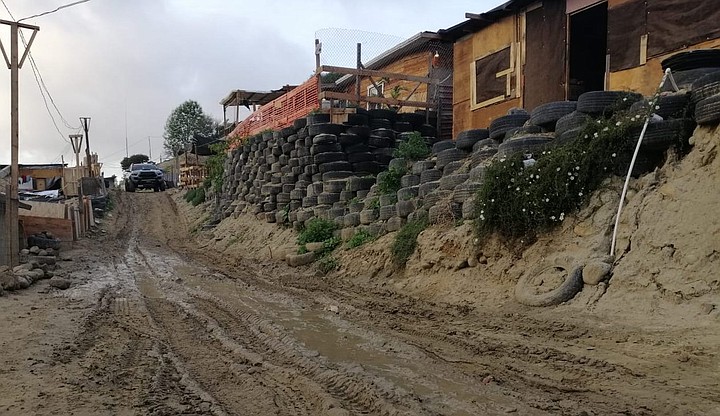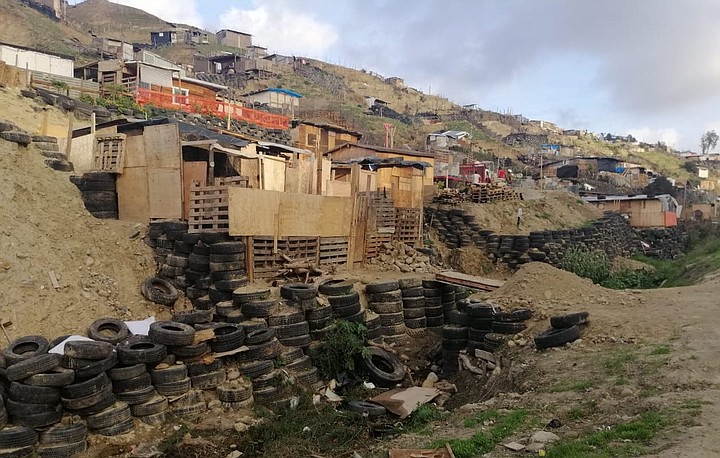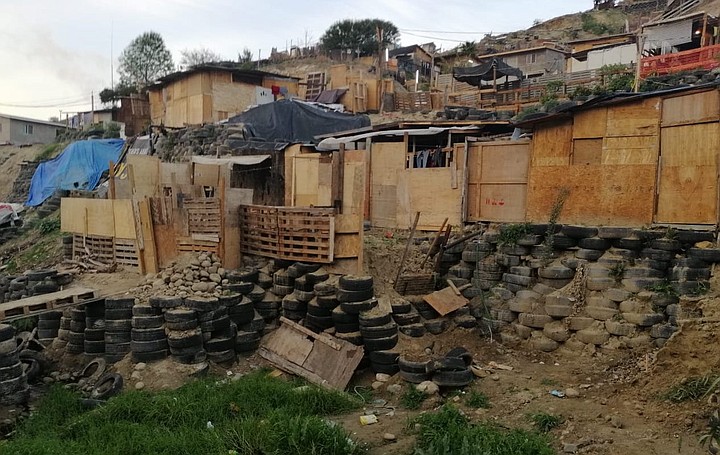 Facebook
Facebook
 X
X
 Instagram
Instagram
 TikTok
TikTok
 Youtube
Youtube

According to data from Baja California's College of the Northern Border, 57 percent of Tijuana’s urban development is settled in dangerous areas. Olga Salas, a master's degree holder from the college, explained that the geography of Tijuana is very rugged and there is a shortage of land for proper housing..
"Most of the population has settled on irregular properties, and people prefer to stay irregular because of the burdensome and complex bureaucracy. For instance, you can’t build at a 15 degree angle close to cliffs because the land would slide due to water filtrations from rain or domestic sources."

Without power in their home of less than six square yards and built over piles of recycled tires, earth, and debris, Rene Romero and his wife are one example of that part of Tijuana's population living in uninhabitable spots that puts them in danger.
Romero's a 70-year-old man whose sons are no longer talking to him. He lives on Ramp Santos Degollados, not too far from the access to Playas de Tijuana. The name of the street where he lives now is unknown to him. No public service is available for the 20 houses in this new settlement because they are not paying land taxes.
“I'm originally from Zacatecas and came to Tijuana 30 years ago, but in this neighborhood, I have been living just two years, and we decided to build a house here because we saw other people wanting a lot to live on as well," Romero stated. For Olga Salas, this is another reason for people to put themselves in danger zones – the hope of having their own place. "For them this is the only chance to have land."
This means to start from zero for Romero and his neighbors; they have a committee to get organized and help each other to cover certain necessities. Another neighbor, Maria del Refugio, noted that no one from the municipality has talked to them, and they have been ignored. "We all gather money to pay for a caterpillar (tractor) to open a way out the neighborhood because otherwise, we wouldn't have a street."
Plus, their inaccessibility represents an obstacle for the emergency services or police patrols. The danger of landslides is a constant risk. Cliffs, canyons, natural drain flows, and settlements close to rivers are highly exposed to catastrophes.

According to Salas, the urban developments usually cut down the coastal sage scrub, which has a role in the control of the heat and helps to keep the land compact. The deforestation contributes to the vulnerability.
Salas highlighted that maquiladoras, which came in the late 70s, had a big influence on the increase of the city population. Despite Romero's more than 30 years living in Tijuana, he was not able to have his own house till now; because of losing his most recent job, he had to leave the last house he was renting.

“Here people help me giving me pieces of wood to finish my house or make deliveries for neighbors. I sell ice cream but this weather doesn't help. I can't work in a maquila any more; I'm old, and they asked too many requirements."
Last month a landslide that rendered more than 40 houses uninhabitable took place in the Sanchez Taboada district. There the director of Tijuana’s Civil Protection, Jose Luis Rosas, admitted that there is now a great zone of risk in the city due to the complexity of the topographic characteristics of Tijuana.
According to the Atlas of Natural Hazards, there have been 23 similar disasters since 2014, and most of them have happened in the San Antonio de los Buenos district, where Rene Romero has settled with his wife.


According to data from Baja California's College of the Northern Border, 57 percent of Tijuana’s urban development is settled in dangerous areas. Olga Salas, a master's degree holder from the college, explained that the geography of Tijuana is very rugged and there is a shortage of land for proper housing..
"Most of the population has settled on irregular properties, and people prefer to stay irregular because of the burdensome and complex bureaucracy. For instance, you can’t build at a 15 degree angle close to cliffs because the land would slide due to water filtrations from rain or domestic sources."

Without power in their home of less than six square yards and built over piles of recycled tires, earth, and debris, Rene Romero and his wife are one example of that part of Tijuana's population living in uninhabitable spots that puts them in danger.
Romero's a 70-year-old man whose sons are no longer talking to him. He lives on Ramp Santos Degollados, not too far from the access to Playas de Tijuana. The name of the street where he lives now is unknown to him. No public service is available for the 20 houses in this new settlement because they are not paying land taxes.
“I'm originally from Zacatecas and came to Tijuana 30 years ago, but in this neighborhood, I have been living just two years, and we decided to build a house here because we saw other people wanting a lot to live on as well," Romero stated. For Olga Salas, this is another reason for people to put themselves in danger zones – the hope of having their own place. "For them this is the only chance to have land."
This means to start from zero for Romero and his neighbors; they have a committee to get organized and help each other to cover certain necessities. Another neighbor, Maria del Refugio, noted that no one from the municipality has talked to them, and they have been ignored. "We all gather money to pay for a caterpillar (tractor) to open a way out the neighborhood because otherwise, we wouldn't have a street."
Plus, their inaccessibility represents an obstacle for the emergency services or police patrols. The danger of landslides is a constant risk. Cliffs, canyons, natural drain flows, and settlements close to rivers are highly exposed to catastrophes.

According to Salas, the urban developments usually cut down the coastal sage scrub, which has a role in the control of the heat and helps to keep the land compact. The deforestation contributes to the vulnerability.
Salas highlighted that maquiladoras, which came in the late 70s, had a big influence on the increase of the city population. Despite Romero's more than 30 years living in Tijuana, he was not able to have his own house till now; because of losing his most recent job, he had to leave the last house he was renting.

“Here people help me giving me pieces of wood to finish my house or make deliveries for neighbors. I sell ice cream but this weather doesn't help. I can't work in a maquila any more; I'm old, and they asked too many requirements."
Last month a landslide that rendered more than 40 houses uninhabitable took place in the Sanchez Taboada district. There the director of Tijuana’s Civil Protection, Jose Luis Rosas, admitted that there is now a great zone of risk in the city due to the complexity of the topographic characteristics of Tijuana.
According to the Atlas of Natural Hazards, there have been 23 similar disasters since 2014, and most of them have happened in the San Antonio de los Buenos district, where Rene Romero has settled with his wife.
Comments